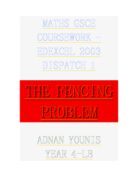From this I can easily work out the height of the triangle by using Pythagoras’s theorem because when splitting a isosceles triangle in two. The halves are always right angle triangles (see below).
To work out the height I will use the equation below:
Height2 = slant height2 – (base2/2)
I will use this equation to work out the height of the triangle with a base of 200m.
Height2 = 4002 – (2002/2)
= 140,000
To get just height I will have to square root the answer above:
Height2 = 140,000
Height = 374.17m
Prediction
I predict that with the rectangles the square will have the highest area of the rectangles. Also I predict that with the Triangles the equilateral triangle will have the highest area of the triangles. I also predict that as the amount of sides rises the area will also rise I believe this because all the shapes can be split up into isosceles triangles and as the shapes get bigger the amount of isosceles triangles will also increase which means the area will therefore increase. This is why I believe that the circle is the shape with the highest area because it has infinite sides, which means it has the highest amount of sides.
Rectangles
As you can see from the graph that it is a Parabolas graph, which means that there are quadratic equations involved. From my table and graph you can see that the highest area is a Square or a regular quadrilateral. I only measured to the nearest 10m I cannot tell if this is true. So I will test to see what the area is when the width is: 249m, 249.5m 249.75m, 250m, 250.25, 250.5, and 251m.
All of the results fit into the graph. This shows that my graph is reliable and it is a Parabolas graph and a quadratic equation was used which is: Area = x(500-x) where x = width.
Triangles
The regular rectangle is the biggest but as with the squares I will check to see if the numbers around it fit into the graph. The extra widths I will take are: 333m, 333.25m, 333.3 recurring, 333.5m, 333.75 and 334m.
The triangle graph and the rectangle give proof that the regular shape has the biggest area.
Because the last two shapes have had the largest areas when regular. From now on I am going to just use regular shapes, this is a lot easier because all the other shapes as they get bigger will have millions of different variables.
Pentagon
Because there are five sides to a pentagon I can divide it into five equal segments. Each segment will be an isosceles triangle.
The top angle of the isosceles will be 72o because it is 360/5. It is easy to work out the other two by doing (180-72)/2 = 54o
As I have said earlier I can divide the isosceles into two to make a right angle triangle. So using Trigonometry I can work out the height of the triangle. SOCAHTOA.
100 = ½ Base
Height of segment = 100tan54
= 137.638m
From this I can work out the area using ½ b*h.
Area of segment = ½ 200*137.638
= 13,763.8192
13,763.8192 this equals the area of one segment so to find the area of the pentagon I will have to times it by 5.
Area of pentagon = 13,763.8192*5
= 68819.09602
Hexagon
360/6 = 60 (180-60)/2= 60
SOCAHTOA
Base= 1000/6 = 166.6 recurring/2 = 83.3 recurring
Height= 83.3 recurring*tan60 = 144.338
Area = ½ b*h
= ½ 166.6 recurring*144.338
= 12028.13061
total area of hexagon = 12028.13061*6
= 72168.78365
Heptagon
360/7 =51.429 (180-51.429)/2 = 64.2857
SOCAHTOA
Base= 1000/7 = 142.857/2 = 71.4285
Height= 71.4285*tan64.2857 = 148.323
Area = ½ b*h
= ½ 142.857*148.323
= 10594.47957
total area of heptagon = 10594.47957*7
= 74161.35699
This shows that my prediction is correct as the number of sides increase the area increases.
Formula with nth term
From the pentagon (5 sides), hexagon (6 sides) and heptagon (7sides) I can work out a formula using n as the number of sides. Where P is perimeter
The method:
Base length = P/n
½ Base length = (P/n)/2
Bottom angle of segment = ((180-(360/n))/2)
Height = ((P/n)/2)*tan((180-(360/n))/2)
Area of segment = ½ (P/n)*((P/n)/2)*tan((180-(360/n))/2)
Total area of shape = (½ (P/n)*((P/n)/2)*tan((180-(360/n))/2))
Number of sides to Area
The graph which shows the pattern between the increasing number of sides and the increasing area on the page before becomes an asymptote, an asymptote is a graph which gets closer and closer to a horizontal straight line but never gets to that point.
This explanation of this graph proves to me that the circle is the highest area possible because as we increase the sides the area also increases, the graph will go on forever. This is why the circle has the highest area it has an infinite number of sides. So theoretically the graph will go on forever until we reach infinity and will then stop to show the circle to be the shape with the highest area because it has infinite sides.
Area of a Circle
Circumference of circle = 1000 Circumference of a circle = πd
Diameter = 1000/π = 318.3098
Radius = d/2 = 159.1549
Area = πr2
Area = π*159.15492 = 79577.471553
This work has proven that the farmer should use the 1000m of fence to build a circle because it has the biggest area.







